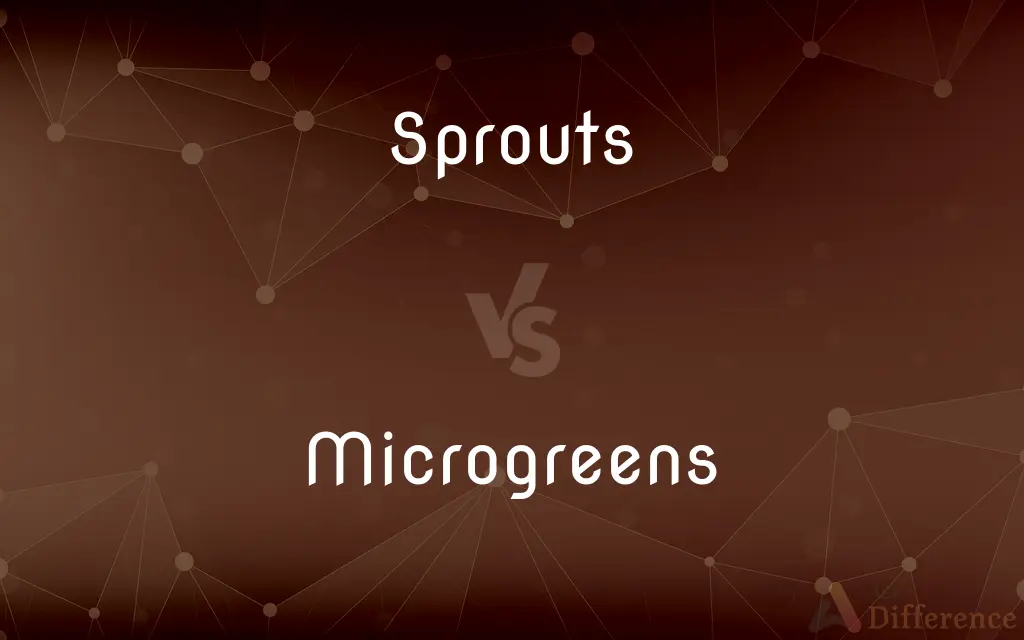Sprouts vs. Microgreens — What's the Difference?
By Fiza Rafique & Maham Liaqat — Published on August 6, 2024
Sprouts are germinated seeds that are eaten whole, including the root, stem, and undeveloped leaves. Microgreens are young vegetable greens harvested just after the first true leaves have developed.

Difference Between Sprouts and Microgreens
Table of Contents
ADVERTISEMENT
Key Differences
Sprouts are produced by soaking seeds for several hours and then allowing them to germinate, creating a tiny, edible plant within just a few days. This process is typically done in water, using a jar or a tray, without the need for soil or sunlight. The entire sprout is consumed, from root to shoot, including the seed. Microgreens, conversely, are grown in soil or a soil substitute, require sunlight for photosynthesis, and are harvested when they are slightly larger than sprouts, usually 1-3 weeks after germination, when the first true leaves have emerged.
The nutritional profiles of sprouts and microgreens are both highly regarded, though they differ significantly due to their growth stages and conditions. Sprouts are known for their high enzyme content and digestibility, as well as vitamins, minerals, and antioxidants. Microgreens, however, are often considered more nutrient-dense compared to sprouts and mature vegetables, containing higher levels of vitamins, minerals, and antioxidants, which are enhanced through the process of photosynthesis.
Cultivation and harvesting practices also distinguish the two. Sprouts can be grown year-round, indoors, and require minimal space, making them an accessible option for home cultivation. Microgreens demand more attention, including proper lighting and air circulation, and they are usually grown in shallow containers or trays filled with soil or a peat-moss-based mixture. While sprouts are ready to eat in about 3-7 days, microgreens take a bit longer, from 7 to 21 days before they are ready for harvest.
In terms of culinary use, sprouts are often used raw and added to salads, sandwiches, and wraps to provide a crunchy texture and a slight nutty flavor. Due to concerns about bacterial contamination, it's recommended to cook sprouts before eating to ensure safety. Microgreens, with their more developed flavor profiles, ranging from sweet to spicy depending on the variety, are used to enhance the taste, visual appeal, and nutritional content of dishes, and they can be enjoyed both raw and cooked.
The risk of bacterial contamination, particularly with sprouts, is a significant difference, given the warm, moist environments required for their growth, which are ideal for bacteria like Salmonella, E. coli, and Listeria. Microgreens, grown in less humid conditions and harvested above the soil line, typically have a lower risk of contamination. However, good hygiene practices are essential in growing both sprouts and microgreens to minimize any health risks.
ADVERTISEMENT
Comparison Chart
Growth Medium
Water, no soil required
Soil or a soil substitute
Light Requirement
No sunlight required
Require sunlight for photosynthesis
Part of Plant Eaten
Entire plant (root, seed, stem)
Stem and leaves, roots not eaten
Nutritional Content
High in enzymes, vitamins, and minerals
Often higher in vitamins, minerals, and antioxidants than sprouts and mature plants
Harvest Time
3-7 days after germination
7-21 days after germination, after first true leaves appear
Culinary Uses
Used raw in salads, sandwiches; should be cooked to reduce bacterial risk
Used raw or cooked to enhance flavor and nutrition in various dishes
Risk of Contamination
Higher, due to moist germination environment
Lower, grown in less humid conditions and harvested above soil
Compare with Definitions
Sprouts
Edible germinated seeds that include the root, seed, and shoot, consumed whole.
Alfalfa sprouts add a crunchy texture to her salad.
Microgreens
Referring to foods that are high in nutrients compared to their caloric content, a characteristic of microgreens.
The kale microgreens were particularly nutrient-dense, adding both flavor and vitamins to the salad.
Sprouts
The process by which a plant grows from a seed.
The germination of mung bean seeds in a jar over several days resulted in a batch of fresh sprouts.
Microgreens
Young vegetable greens harvested shortly after the cotyledon leaves have developed, known for their intense flavors and nutritional value.
The chef garnished the dish with radish microgreens for a burst of color and peppery flavor.
Sprouts
Sprouts have high enzyme levels that aid in digestion and nutrient absorption.
The high enzyme content in broccoli sprouts may help improve digestion.
Microgreens
The first leaves that appear on a seedling, followed by the development of true leaves in microgreens.
Once the cotyledon leaves were fully developed, the microgreens were ready to be harvested.
Sprouts
Sprouts can harbor harmful bacteria if not grown or handled properly.
He ensured his sprouts were thoroughly cooked to avoid the risk of bacterial contamination.
Microgreens
The process by which plants use sunlight to synthesize nutrients from carbon dioxide and water, contributing to the nutrient density of microgreens.
The microgreens were placed under grow lights to promote photosynthesis, enhancing their nutritional content.
Sprouts
To begin to grow; give off shoots or buds.
Microgreens
Plural of microgreen
Sprouts
To emerge and develop rapidly
Businesses that sprouted along the highway.
Sprouts
To allow or cause to come forth and grow
He sprouted a mustache.
Sprouts
Young plant growth, such as a bud or shoot.
Sprouts
The young shoots of plants such as alfalfa and soybean, usually eaten raw.
Sprouts
Brussels sprouts.
Sprouts
Plural of sprout
Common Curiosities
Are sprouts or microgreens easier to grow at home?
Sprouts are generally easier to grow at home since they don't require soil or light, just a jar and water.
Are sprouts or microgreens more nutritious?
Both are nutritious, but microgreens generally contain higher concentrations of vitamins and minerals due to their developed leaves and the process of photosynthesis.
Can sprouts and microgreens be grown from the same seeds?
While many seeds can be used to grow both sprouts and microgreens, the cultivation method and stage of harvest differ.
How do you ensure the safety of sprouts and microgreens?
For sprouts, ensure they are thoroughly washed and possibly opt for homegrown to control the growing conditions. For microgreens, use clean soil and water, and practice good hygiene.
Which is more expensive, sprouts or microgreens?
Microgreens tend to be more expensive due to the longer growing time, need for soil, and light, and their status as a gourmet food item.
Can microgreens be reused after cutting?
Most microgreens do not regrow after harvesting, but some may produce a second, smaller crop if not cut too low.
Do sprouts and microgreens taste the same?
The taste can vary significantly between sprouts and microgreens, with microgreens generally offering a more intense flavor profile.
Are there any risks associated with consuming sprouts or microgreens?
While generally safe, there is a risk of contamination from bacteria, so proper handling and hygiene are essential.
What is the shelf life of sprouts and microgreens?
Sprouts typically last about a week in the refrigerator, while microgreens can last up to two weeks when stored properly.
Can growing microgreens at home save money?
Growing microgreens at home can be cost-effective, especially if you consume them regularly, as store-bought microgreens can be pricey.
Can you grow microgreens from any plant?
Not all plants are suitable for microgreen cultivation, but many vegetables, herbs, and edible flowers can be grown as microgreens.
How do you incorporate sprouts and microgreens into meals?
Sprouts can be added to sandwiches, salads, and wraps for a crunchy texture, while microgreens can be used as garnishes, in salads, and to add a flavor boost to a variety of dishes.
What are the environmental impacts of growing sprouts and microgreens?
Both have low environmental impacts compared to fully grown vegetables, but microgreens require more resources like soil and light.
How do sprouts and microgreens compare in terms of sustainability?
Both are sustainable options with low resource requirements, though microgreens need more space and light, slightly increasing their environmental footprint.
Can microgreens and sprouts be frozen for later use?
Freezing can compromise their texture and nutritional value; it's best to consume them fresh.
Share Your Discovery

Previous Comparison
Autonomic Movements vs. Paratonic Movements
Next Comparison
Solvation Energy vs. Lattice EnergyAuthor Spotlight
Written by
Fiza RafiqueFiza Rafique is a skilled content writer at AskDifference.com, where she meticulously refines and enhances written pieces. Drawing from her vast editorial expertise, Fiza ensures clarity, accuracy, and precision in every article. Passionate about language, she continually seeks to elevate the quality of content for readers worldwide.
Co-written by
Maham Liaqat












































